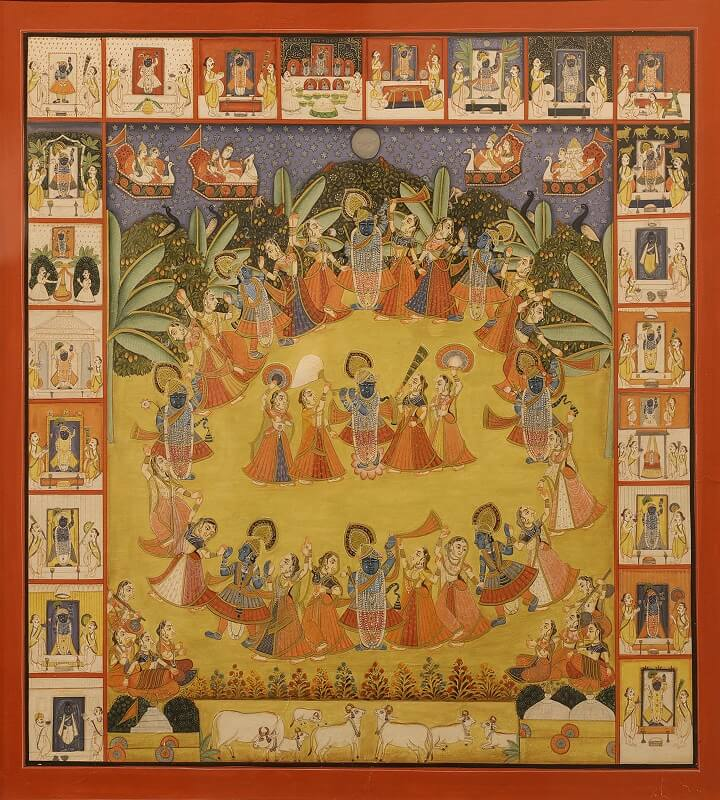Reviving the Sacred Art of Pichwai Paintings: A Journey Through Tradition and Modernity in Nathdwara
Pichwai painting is one of India's most revered forms of devotional art, deeply rooted in the sacred town of Nathdwara, near Udaipur, Rajasthan. These intricate artworks, known as Pichwai Paintings Nathdwara, were traditionally used as ornate backdrops in temples to honor Shrinathji, a child manifestation of Lord Krishna. Beyond their visual richness, Pichwais carry spiritual significance—each brushstroke is an offering of devotion, created not simply as decoration but as a sacred act of worship.
The word "Pichwai" itself comes from the Sanskrit words pichh (back) and wai (hanging), indicating its traditional function as a backdrop for temple rituals. Dating back over 400 years, these paintings emerged alongside the Pushtmarg sect, founded by the saint Vallabhacharya. According to legend, Vallabhacharya brought the swaroop (divine image) of Shrinathji from Govardhan Parvat to Nathdwara to protect it from Mughal invasions. Artists followed, settling in what became known as chitrakaron ki gali (the painters' street), thus laying the foundation for the Nathdwara school of painting.
Over time, Pichwai Paintings Nathdwara evolved by absorbing stylistic influences from across Rajasthan and Mughal ateliers. The vibrant colors and bold outlines of Mewar, the intricate finesse of the Jaipur and Mughal miniature schools, and the ethereal elegance of Kishangarh paintings all left their imprint. Particularly, the Kishangarh style's iconic almond-shaped, half-closed eyes became a hallmark of Shrinathji depictions in Pichwais.
What makes Pichwai Paintings Nathdwara truly unique is their visual language. Dreamy-eyed cows, gopis, lotuses, mango trees, and seasonal symbols are woven together with architectural elements to portray scenes from Krishna's life and temple festivals. Paintings were created in alignment with the Hindu calendar and were frequently changed according to seasons or occasions like Annakut, Gopashtami, and Sharad Purnima. The portrayal of Shrinathji with his downward gaze, symbolic blue-black complexion, and embellished attire reflects not just artistic skill but spiritual symbolism.
In recent times, however, the art form faced a decline in both awareness and patronage. Traditional artists struggled to find relevance in a changing world, and mass-produced imitations threatened to reduce this rich tradition to mere souvenirs. Enter Pichwai Tradition And Beyond, an innovative initiative led by artist and curator Pooja Singhal. Her platform reinterprets the art of Nathdwara for modern times, while preserving its devotional essence.
Pichwai Tradition And Beyond has been instrumental in giving this sacred art form a new identity. Through collaborations with skilled traditional artists and miniature painters, the atelier has created works on both cloth and paper, ranging from miniature to large-scale compositions. While retaining core motifs and traditional techniques, the works explore newer themes, modern palettes, and curated design sensibilities suitable for contemporary spaces.
Under Singhal's vision, Pichwai Tradition And Beyond not only revives the art but also recontextualizes it. Her collections feature stylized temple maps, deconstructed compositions, Mughal-inspired detailing, and abstracted forms of sacred trees and cows—each thoughtfully designed to maintain the spiritual narrative while expanding its artistic vocabulary.
Today, Pichwai Paintings Nathdwara are no longer confined to temple walls. They grace galleries, homes, luxury interiors, and international exhibitions, appreciated for both their aesthetic charm and cultural depth. More importantly, they continue to inspire a spiritual connection, offering a moment of contemplation in a chaotic world.
By bridging the gap between tradition and modernity, Pichwai Tradition And Beyond ensures that this centuries-old art form not only survives but thrives. Through innovation rooted in devotion, it invites us to engage with history—not as a relic but as a living, breathing expression of divine beauty.















